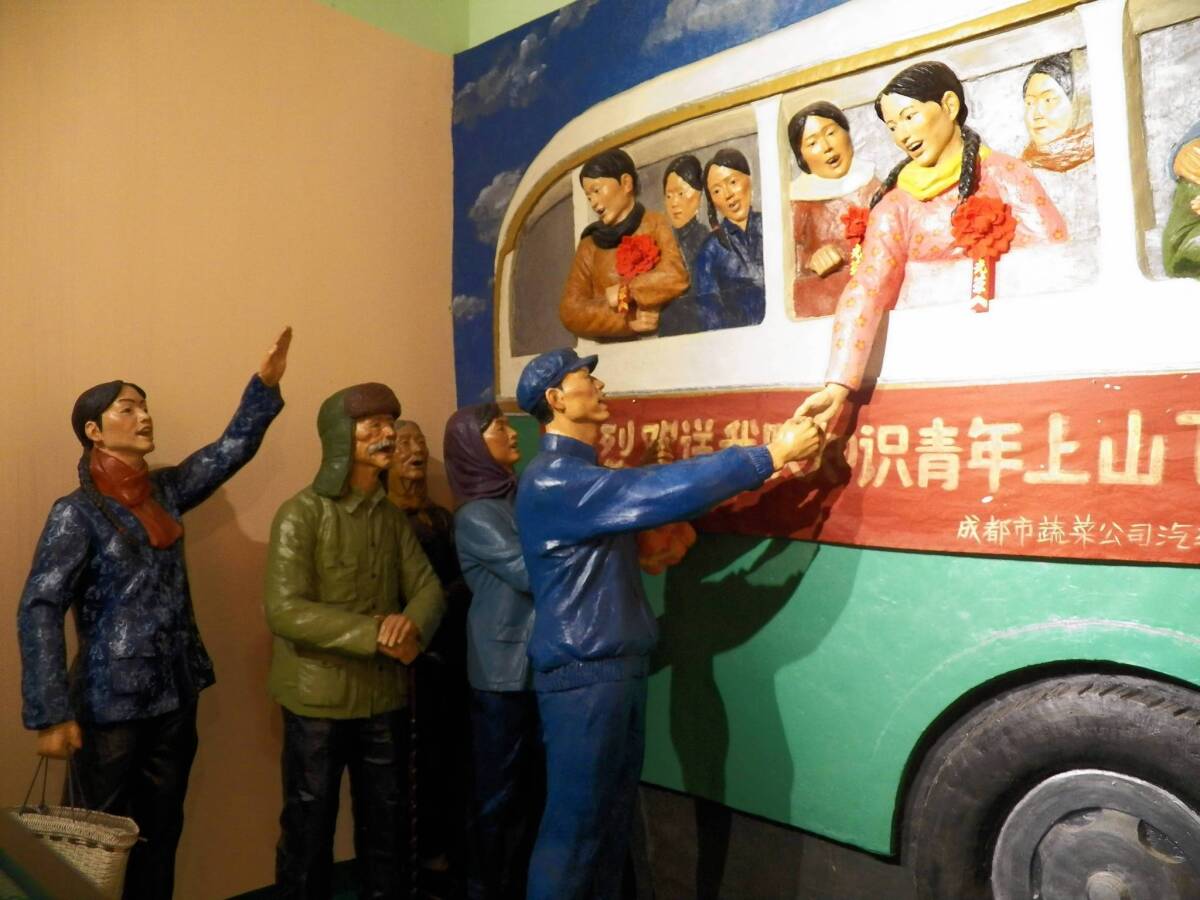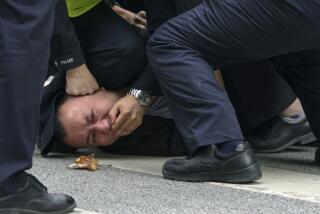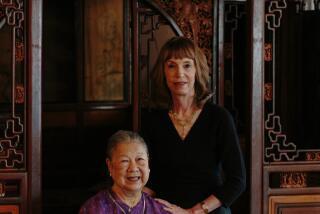China museum builder lets history speak

ANREN, China â From floor to ceiling, wall to wall, the narrow entry corridor at the Red Era Daily Necessities Museum is bathed in a blood-red light. There is no map, no brochure, no choice of direction; the architecture forces visitors forward, over glowing panels labeled by year: 1966. 1967. 1968. A few dozen paces later: 1976.
A roar comes from a sea of Red Guards in Tiananmen Square, chanting rabidly, captured in a film clip from the era. Mao Tse-tung strides into the frame, whipping the crowd into a frenzy.
The dawn of the Cultural Revolution in 1966 brought a decade of chaos, violence and persecution that ripped China apart. Friends denounced friends, parading them in dunce caps through the streets. Roving mobs smashed religious relics to bits. Mao was elevated to the status of a god, his face stamped onto billions of lapel pins worn like talismans.
Then it was over. The Communist Party declared it all a grave error. Even now, authorities and many average citizens have no stomach for looking back on the era.
When Beijingâs National Museum reopened last year after a nearly four-year makeover, curators devoted only a single photo and three lines of text to the Cultural Revolution, focusing instead on more glorious moments: the 1949 communist victory and the last 30 years of reform.
Yet in this small town 1,200 miles southwest of the capital, Fan Jianchuan has embarked on a quest to collect, preserve and display millions of objects, documents and recordings from the Cultural Revolution: photos, diaries, letters, pots and pans, marriage certificates, a piano.
Fan is one of Chinaâs most obsessive collectors and one of its wealthiest men. Since 2005, he has used his fortune and savvy to open five museums devoted to different aspects of what he calls the âRed Era.â Construction of a sixth has just been completed, and he envisions a total of 12.
The Cultural Revolution museums are part of what Fan calls the Jianchuan Museum Cluster, a sprawling complex on which he figures he has spent about $200 million. Besides the Red Era buildings, the cluster includes museums focusing on other politically sensitive events; seven look at the 1931-45 Sino-Japanese War, and three focus on the 2008 earthquake here in Sichuan province that killed more than 68,000 people.
A visit to the complex is dizzying. Each building is several thousand square feet, and is dedicated to its niche, be it Mao badges or propaganda mirrors, or the contributions of the American Flying Tigers during the Sino-Japanese War. A visitor could spend three days here and not see everything.
Heâs got other touchy subjects in mind. One is the Great Leap Forward, Maoâs 1958-61 attempt at rapid industrialization that ended in massive famine. Heâs also gathering items on contemporary problems, such as migrant workers, food safety and the 2011 high-speed train crash in Wenzhou that killed 40 people and exposed corruption in the nationâs public railway system.
âWhen the Sanlu tainted milk powder incident broke out, I rushed to the supermarket and told the shop assistant, âMy baby enjoys eating Sanlu.â So I was able to buy two boxes,â Fan said. âAfter the Wenzhou train accident, we were able to collect some doors and windows from the wreckage.â
In a country where offering a perspective that veers from the party line can bring harsh consequences â activists, artists and others have faced detention, fines and surveillance for speaking out or appealing what they say are unfair decisions by local authorities â Fan regards the fact that heâs been allowed to proceed as a heartening sign of progress.
âFrom my museum, you can understand the degree of opening and reform,â said Fan, 55, sipping tea and puffing through a pack of Yellow Crane Tower cigarettes. âI want to do things actively, but I want to keep it stable.... Even when Iâm talking to you now, I feel butterflies in my stomach. Because if anything in your article is too ahead of its time, it might cause trouble for the museum.â
Zhang Ming, a professor in the political science department at Peopleâs University in Beijing, said Fanâs interest in topics such as the Cultural Revolution and the Great Leap Forward helps fill a void left by the state.
âThe government is not interested in these issues,â Zhang said. âIf you look at the Communist Partyâs 60 years of rule in China, there are 30 years they donât want to talk about.â
::
Other than his kindergarten report card, the first things Fan can remember collecting were printed denunciations of his father. He was 9 years old.
âIn 1966, my dad was attacked. He lost his freedom. He was criticized,â Fan recalled. âHe needed me to gather up any brochures, notices or posters that contained information about him, to show it to him,â so he could minimize the damage to his reputation.
He paused. âBut thatâs not the most important reason why I became a collector. My dad also told me I had to be responsible, to contribute to society and not be afraid to take risks. That influenced me greatly.â
Dressed in camouflage pants and a black T-shirt, Fan talked passionately about his childhood in Sichuan, and his teenage years, when he earned 9 cents a day growing sweet potatoes, rice and corn as one of millions of educated âintellectual youthâ forced into rural labor.
Later, Fan parlayed a teaching job at a military college into a position as vice mayor of a small town. But in the early 1990s, he quit. After working for a Hong Kong businessman for about a year, Fan borrowed money from friends and a bank to build hotels and commercial and residential properties. By 2007, he ranked No. 397 on the Hurun Reportâs China Rich List, with his wealth pegged at $270 million.
Fanâs real passion was collecting. Among his holdings, amassed through a network of antique dealers as well as donations, are two tons of Mao badges; 30 tons of written self-criticisms, in which Chinese were forced to criticize their behavior or thinking; 100 tons of newspapers; more than 100,000 music recordings; thousands of videotapes; and 100,000 letters.
Fan said the idea for the museums began to gestate in 2000, and in 2002 he obtained 80 acres in Anren. In 2005, he opened the Museum Cluster and has been expanding it continuously.
âIn the beginning I thought museums were so sacred that only the country can build museums,â Fan said. âThen I realized my relics are not any worse than the National Museumâs collections.â
Hundreds of private museums have sprouted up in China in the last decade as the nationâs nouveaux riches have built pavilions to showcase their collections of paintings or porcelain and assert their status. But Fan is one of the few who has dared to focus on history, let alone the recent past.
Fanâs wealth and party connections havenât hurt him, and some say his remote location has given him more latitude.
At times, supporters in provincial-level positions have looked the other way. Fan has also embraced specific strategies to deal with potential objections.
For starters, the cluster has a motto, displayed on placards: âWe donât speak, we let history speak.â Introductions are kept brief, with few sweeping statements citing death tolls or other statistics. Fan also takes care to avoid hot-button words, hence the âRed Eraâ in the museum names, instead of âCultural Revolution.â
Instead of drawing up plans and submitting them for approval, Fan builds first and then sees if anyone will try to stand in his way.
âFrom what I know, he didnât have to say exactly what he was building,â Zhang said. âHe just started to build, and when he wanted to add something he did it in a way that was not very direct.â
::
Fan may keep interpretive signage to a minimum, but the physical design of his displays often conveys powerful messages.
The Red Era Mirror Museum â featuring thousands of wall mirrors imprinted with various propaganda slogans that were manufactured during the Cultural Revolution and displayed in peopleâs homes â is a disorienting maze reminiscent of a boardwalk-style Hall of Mirrors. Visitors gazing into the reflecting glass can see how even a simple act like checking oneâs appearance became an opportunity for the state to impart a lesson.
But not all of Fanâs carefulness can be chalked up to a need to dance around official red lines. Those who lived through the Cultural Revolution have varying perspectives on how to assess what transpired.
A woman in her 60s from Jiangsu province, touring the Mao Badges museum with her husband, said she worked in a factory during the Cultural Revolution, and recalled with a smile that she had a small Mao badge while the bosses had big ones.
Asked how she looks back on that period now, the woman hesitated. Her husband shot her a stern look.
âItâs just Chinese history,â she said, evasively. âI canât comment on it.â Her husband interjected: âWe have a good life now.â
Quickly drawing conclusions about an event that touched 800 million people and twisted through 10 years will take a long time, Fan says.
âAs long as the relics are here, in 10, 20, 30 years,â he said, âthe history will get clearer and clearer.â
Tommy Yang and Nicole Liu of The Timesâ Beijing bureau contributed to this report.
More to Read
Sign up for Essential California
The most important California stories and recommendations in your inbox every morning.
You may occasionally receive promotional content from the Los Angeles Times.











